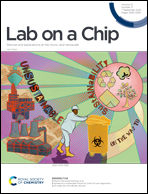A fully automated primary neuron purification system using continuous centrifugal microfluidics†
Abstract
Progress in neurological research has experienced bottlenecks owing to the limited availability of purified primary neurons. Since neuronal cells are non-proliferative, it is necessary to obtain purified neurons from animal models or human patients for experimental work. However, currently available methods for purifying primary neurons are time-consuming (taking approximately 1 week), and suffer from insufficient viability and purity. Here, we report a method for rapid enrichment of neurons from the mouse embryonic dorsal root ganglion (DRG), using a fully-automated continuous centrifugal microfluidics (CCM) based neuron purification disc (NPD). Non-neuronal cells were removed via negative depletion by combining density gradient centrifugation and immunomagnetic separation. The CCM-NPD platform enables effective isolation of intact neurons within 13 min, which is approximately 800 times faster than the conventional chemical purification method. Furthermore, the neurons purified using the CCM-NPD platform showed better neurite growth, along with higher viability (93.5%) and purity (97.0%) after 1 week of culture, compared to the chemical purification method. Therefore, the proposed automated and rapid system yields purified DRG neurons with high viability and purity, while avoiding the use of harsh chemicals. We believe this system will significantly mitigate the shortage of purified primary neurons and advance neurological research.



 Please wait while we load your content...
Please wait while we load your content...